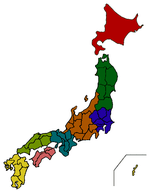Kanayama Castle
Kanayama Castle (金山城, Kanayama-jō), also known as Ōta Kanayama Castle and as Nitta Kanayama Castle, is a yamashiro (castle sited on a hill) located on top of Mount Kanayama in Ōta, Gunma Prefecture, Japan.
History
Kanayama Castle was built in 1469 by Iwamatsu Iezumi. In 1528, a retainer of the Iwamatsu Clan, Yokose Narishige (his family later changed their name to Yura), began ruling over it. The castle withstood sieges by Uesugi Kenshin in 1574, Takeda Katsuyori in 1580, and Satake Yoshishige in 1583. The Hōjō clan captured the lord of Tatebayashi Castle, Nagao Akinaga, and Yura Kunishige, the Kanayama castle was defended by his mother, Akai Teruko, at that time. The two brothers gave the Hōjō Kanayama Castle, under the condition that he be released. In 1590, as part of Toyotomi Hideyoshi's campaign against the Hōjō, Kanayama Castle was seized by Maeda Toshiie. Following this, the castle was abandoned and never used again.[1] The castle's ruins (which have partly been restored) are currently maintained by the City of Ota.
It was long believed that the tenshu (keep) of Kanayama Castle was moved to Inuyama Castle by Ishikawa Mitsuyoshi in 1559. This theory was disproved by archeological examinations undertaken during restoration works, which involved the dismantling of the castle's donjon, carried out between 1961 and 1965.[2]
References
- Kanayama Castle Archived 2008-03-13 at the Wayback Machine
- Nanjō, Norio; Tatsuya Naramoto (1989). Nihon no meijō kojō jiten (in Japanese). Hankyū Communications. p. 240.
